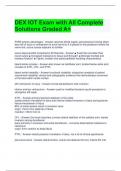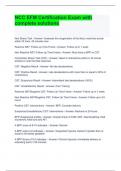DEX IOT Exam with All Complete
Solutions Graded A+
PARS system advantages - Answer-reserves blood supply, percutaneous locking stitch,
less risk of injury or entrapment of sural nerve bc it is placed in the paratenon where the
nerve isnt, suture coarse adjacent to achilles
suture tape benefits compared to #2 fiberwire - Answer-■ Feels flat out better than
round suture ■ Increased resistance to tissue pull-through1 ■ Stronger knotted and
knotless fixation1 ■ Tighter, smaller knot stacks ■ Better handling characteristics
lateral ankle complex - Answer-also known as talofibular joint, located below ankle joint,
consists of ATFL, CFL, and PTFL
lateral ankle instability - Answer-functional instability: subjective complaint of patient
mechanical instability: clinical and radiographic evidence that demonstrates movement
of the talus within ankle mortise
atfl mechanism of injury - Answer-forced plantarflexion and inversion
inferior extinsor retinaculum - Answer-used for modified brostrom gould procedure to
strengthen atfl repair
ATFL - Answer-primary ligament stabilizer of the ankle
resists anterior translation of talus and internal rotation/inversion of talus during plantar
flexion/mechanism of injury
80% of ankle sprains result of inversion injury
origin: 15mm from distal tip of fibula
insertion: 18mm from to
CFL - Answer-2nd most important, primary lateral stabilizer of the subtalar joint, resists
inversion during dorsiflexion
tears primarily in inversion and ankle dorsiflexion - connects distal lateral malleolus to
calcaneus
origin: 4mm anterior to distal fibula
PTFL - Answer-resists posterior translation of talus, not a lot of clinical significance
peroneus brevis - Answer-lateral tendon, everts and abducts the foot, inserts 5th met
,peroneus longus - Answer-lateral tendon, everts foot, inserts 1st met/medial cuneiform
detloid ligament - Answer-serves to resist external rotation of the hindfoot, helps resist
valgus stress on talus, and stabilize the subtalar joint, gives stability to medial ankle
total of 6 ligaments/bands, separated into deep and superficial
superficial (4): from medial mal to sustentaculum tali (calc)!!! - Tibionavicular,
Tibiospring, Tibiocalcaneal (stabilizes the ankle joint & subtalar joint, connection
between distal tibia and calcaneous, most common ligament in deltoid reconstruction),
superficial posterior tibiotalar
deep (2): from medial mal to talus!!! - Deep posterior tibiotalar, Deep anterior tibiotalar
(most common in deltoid reconstruction)
medial ankle joint - Answer-deltoid ligament, consists of:
medial malleolus (tibia)
talus (head supported by calcaneus and spring ligament)
calcaneus (sustentaculum tali where deltoid and spring ligament insert)
deltoid mechanism of injury - Answer-forced eversion and external rotation
spring ligament - Answer-aka calcaneovaciluar ligament (superomedial & inferomedial),
Provides support to medial arch, Thought to also be a main reason for flatfoot deformity
if injured, Goes from ST to navicular, Supports talar head
PTT - Answer-inserts on plantar medial navicular tuberosity
FHL - Answer-connects to first metatarsal, May be used in conjunction with Achilles
reconstruction for tendon balancing with peroneal tendon deficiency
fdl - Answer-connects to lesser metatarsals, done with spring ligament for flatfoot, Used
for Posterior tibial tendon dysfunction
tenodesis screw sizes - Answer-2.5x7
3x8
4.75x15 (&19)
5.5x15
6.25x15
7x23
8x23
brostrom repair - Answer-just repairing atfl, can use fibertaks/suturetaks
brostrom gould repair - Answer-modified brostrom, inferior extinsor retinaculum included
to strengthen atfl repair
Brostrom w/ IB augmentation - Answer-repair atfl with fibertaks, use internal brace as
seatbelt that braces ATFL
, syndesmosis joint - Answer-also known as tibiofiibular ligament,
located above the ankle joint, comprised of:
AITFL: anterior inferior talo-fibular ligament
PITFL: strongest ligament
Tibiofibular Interosseous ligament: membrane running vertically between fibula and tibia
talus anchor in atfl - Answer-2cm from lateral talar process angled 40-45 degrees to the
sagittal plane and parallel with the longitudinal line of fibula, 4:30 for R, 7:30 for L
fibula anchor in atfl - Answer-15mm from distal tip of fibula
tensioning atfl ib - Answer-neutral with 10-15 degrees plantar flexion
medial mal anchor for deltoid ib - Answer-medial mal in intercollicular grove w/ 4.75
anchor
talus anchor in deltoid ib - Answer-deep deltoid, 12.2mm/1cm in talus
sustentaculum tali anchor for deltoid ib - Answer-superficial deltoid, 8mm anterior
deltoid recon - Answer-superficial tibiocalcaneal & deep posterior tibiotalar
superficial deltoid - Answer-4, resists eversion of hindfoot
deep deltoid - Answer-2, medial ankle sprain, lateral ankle sprain, ankle fracture, flatfoot
mechanical instability - Answer-clinical and radiographic evidence that demonstrates
excess movement of the talus within ankle mortise
functional instability - Answer-subjective complaint of patient
sorain classifications - Answer-Grade 1: ATFL sprain
Grade 2: ATFL & CFL partial tear
Grade 3: ATFL, CFL, and possibly PTFL
sural & superficial peroneal - Answer-nerves to watch out for with ATFL IB
syndesmosis mechanism of injury - Answer-forced external rotation of the foot
(specifically talus)
syndesmosis function - Answer-resists movement of:
coronal translation (side to side/left to right)
rotational
sagital translation (forward or backwards)
ideally syndesmosis resists diastesis but allows normal physiological micro-motion





